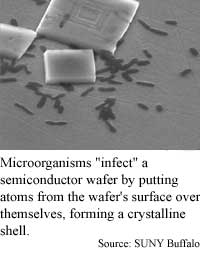
Microorganisms infect computer chips
By Eric Smalley, Technology Research NewsSome microorganisms can cover themselves with semiconductor material, a feat that could boost nascent efforts to integrate living systems with integrated circuits.
The semiconductor shell-making microorganisms were discovered by a coalition of research centers tasked with improving semiconductor yields.
"This was a completely serendipitous finding. We were trying to discover why the ultrapure water supplies in semiconductor manufacture [become infected] from time to time," said Robert Baier, director of the National Science Foundation Center for Biosurfaces at SUNY Buffalo.
The researchers found fifty-nine different microorganisms that were able to survive the harsh semiconductor manufacturing process, which means withstanding vacuum, radiation and toxic chemicals. "They're all living in this extreme environment where there's no nutrition or substratum for them to live on," said Baier.
The microorganisms survive by using atoms from the surface of the semiconductor material to create a crystal shell, sealing themselves off from the outside environment. The microorganisms appear to survive indefinitely, Baier said.
Other researchers have added microorganisms to the surfaces of integrated circuits to create chemical and biological sensors and to create photonic switches from light-emitting microorganisms.
The embedded microorganisms could be put to similar use as components of the integrated circuits themselves. Semiconductor wafers could be doped, or contaminated, with microorganisms to create biotransistors and then processed using standard semiconductor manufacturing techniques to produce the other integrated circuit components, said Baier.
It's not surprising that microorganisms have been found to survive semiconductor manufacturing processes given the discoveries of microorganisms in other harsh environments, said Tom Knight, a senior research scientist in the Artificial Intelligence Laboratory at the Massachusetts Institute of Technology. "It's another set of issues as to whether that's useful for something," he said. But "it's at least intriguing."
Researchers could in theory use the microstructures and processes inside microorganisms to augment computers in several ways, Knight said. For instance, "in a spherical one-micron [space a] cell stores in the vicinity of a megabyte of information," he said. "There's many miracles between where we are and making this happen, but you can imagine using at least a portion of that [capacity] for storing computer information," said Knight, adding that such a scenario is at least 20 to 50 years away.
Another advantage microorganisms could bring to computers is cheap, easy power, Baier said. "Since these things are biological... when it looks like [a biocomputer] is running down you just throw in a sugar cube," he said.
The discovery of embedded microorganisms should also help the researchers solve their original problem of semiconductor contamination, said Baier.
"This discovery restores our faith in basic cleanliness," he said. "What we have to do is provide a lot more opportunity for dissolution of the inorganic shell, exposing the otherwise quite delicate microorganisms to the various assaults we're making on them. It's just very hard to get at them if they're living inside of a rock."
Embedded microorganisms could be used in semiconductor devices within 18 to 24 months, Baier said.
The research on embedded microorganisms was carried out by NSF Center for Biosurfaces at SUNY Buffalo, the NSF Center for Microcontamination Control at the University of Arizona and Rensselaer Polytechnic Institute, the NSF Center for Environmentally Benign Semiconductor Manufacturing at the University of Arizona, and the Queen's University of Belfast, Northern Ireland. The research was funded by the National Science Foundation, the government of the United Kingdom and the industry members of the participating NSF research centers.
Timeline: <2 years
Funding: Government, Corporate
TRN Categories: Biological, Chemical, DNA and Molecular Computing; Semiconductors and Materials
Story Type: News
Related Elements: Images
Advertisements:
September 13, 2000
Page One
Cheap lasers on the way
Nanotubes make microscopic bearings
Integrated inputs improve interactivity
Microorganisms infect computer chips
Sandia brews cheap telecom laser

News:
Research News Roundup
Research Watch blog
Features:
View from the High Ground Q&A
How It Works
RSS Feeds:
News
Ad links:
Buy an ad link
| Advertisements:
|
 |
Ad links: Clear History
Buy an ad link
|
TRN
Newswire and Headline Feeds for Web sites
|
© Copyright Technology Research News, LLC 2000-2006. All rights reserved.